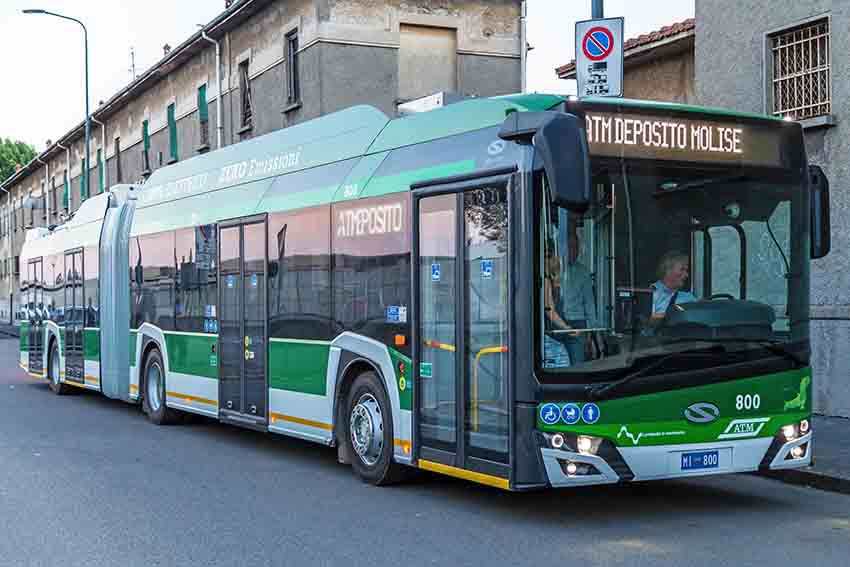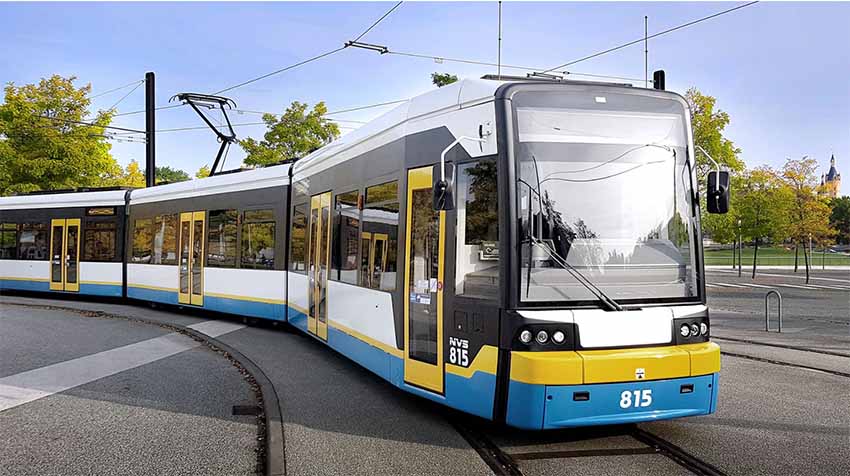Knorr-Bremse subsidiary Kiepe Electric, founded 1906 in Düsseldorf, Germany, is a globally active supplier of electrical systems to the leading rail vehicle and bus manufacturers. The company offers efficient solutions and ecologically sustainable concepts for low-emission public transportation with eco-friendly electrical equipment for light rail vehicles, metros and regional rail networks as well as for battery, trolley and In Motion Charging (IMC) buses.
Easy Engineering: What are the main areas of activity of the company?
Kiepe Electric: Kiepe Electric develops and manufactures traction equipment, on-board power supply systems, vehicle control systems and many electrical components for buses and urban rail vehicles. Our vehicle equipment is supplemented by further systems from other manufacturers to an all-inclusive package and thus supplied to the customer from a single source. Our services range from project planning to the long support of vehicles in line-service operation including manufacturing and commissioning. Due to our personal and long-term project support we realize projects utmost efficiently. A team of experienced experts is always at customer ‘s disposal.
Rail vehicle systems: Kiepe Electric ranks among the leading suppliers of systems for electrified local public transport. Electrical equipment from Kiepe Electric secures to power new and modernized rail vehicles in many cities of the world: e.g. Berlin, Paris, London, Vienna, Kraków, and Taipei.

A groundbreaking LRV modernization project will take place in Schwerin, Germany. The city’s 15-year-old fleet will undergo a modernization and retrofit of its electrical equipment and HVAC systems, 30 low-floor trams are heading for another 20 years’ service. The extended life cycle of the trams will be extended through obsolescence solutions and retrofittable HVAC systems from Kiepe Electric. The project offers a model for many other aging tram fleets.
Road / buses: Furthermore, electrical equipment from Kiepe Electric moves buses in many cities around the world. Solingen, Vancouver, Geneva, Zurich, Athens, Salzburg, Lyon, Milan, Genoa, Mérida, Riga and Quito are only a few examples of cities, in which technology from Kiepe Electric is applied.
A short while ago, major Italian mass transit operators did expand electrified bus services. In Milan, transit authority ATM orders 30 Solaris IMC® buses equipped with electrical systems from Kiepe Electric. In Modena, cutting-edge In-Motion Charging (IMC®) solution results in removal of overhead lines around San Geminiano Cathedral.
Several double-articulated trambuses are in operation in Malatya, Turkey, since about 5 years. Besides direct pulse inverters in IGBT technology the drive motors, the fully automatic current collectors, the braking resistors and the on-board power supply system belong to the scope of supply of Kiepe Electric.

In North American Kiepe Electric has just celebrated the delivery of 278 electric buses for San Francisco. The buses, manufactured by New Flyer in Crookston, Minnesota, are equipped with In Motion Charging Technology (IMC) of Kiepe Electric. The local transit agency in San Francisco (SFMTA) operates the largest fleet of zero emission electric trolley buses in the USA.
E.E: What’s the news for 2020 about new products?
Kiepe Electric: With its electrical components for bus fleets, Kiepe Electric offers solutions for future-proof urban mobility. Smart Fleet Management (SFM), In Motion Charging (IMC®) technology and electric bus kits from Kiepe Electric open up new opportunities for sustainable urban transport.
In Motion Charging 500 (IMC®) from Kiepe Electric is the most effective and efficient charging concept for electric buses on the market. As there is no need for the buses to stop in order to charge their batteries, it eliminates any charging station bottlenecks. With IMC, buses can charge their batteries from the overhead lines while in motion. On sections of route without overhead lines, the vehicles switch to battery power.
The innovative Smart Fleet Management (SFM) system from Kiepe Electric is a self-learning AI energy management system that makes scheduled service operations more robust and increases network capacity. SFM gathers data on consumption, route and performance, and enables automatic and predictive control of buses. SFM covers all kinds of charging concepts, including IMC. Smart Fleet Management is also designed for the latest generation of Kiepe Electric traction equipment for electric vehicles. This includes Kiepe Fleet Management (KFM) which cuts maintenance costs and predicts upcoming maintenance and repair needs, the smart Kiepe Traction Control (KTC) system and the new Kiepe Electric Traction Inverter (KTI).
In its electric bus kit, Kiepe Electric has translated its systems expertise into a future-proof customer offering. This comprises the plug & play assembly of complex systems, predictive maintenance, smart fleet management and digitized solutions.
To advance digitization Kiepe Electric has also reorganized its range of aftermarket services, adding new services to align its portfolio with future customer requirements. Vehicle data management (big data analysis) and the resultant services such as condition-based maintenance are set to increase vehicle availability and cut life cycle costs, based on service level agreements. Along with energy efficiency advice and battery management for trolleybuses (including aspects such as 2nd life, life extension and recycling) standard features of the portfolio also include spare part- and obsolescence management. One of the major new services however is the retrofit of diesel driven trains and busses as well as the update of trolley-busses with IMC technology to extend the bus line range without additional wiring.

E.E: What can you tell us about market trends?
Kiepe Electric: Major global megatrends including urbanization, sustainability, digitization and mobility offer the promise of long-term, sustainable growth for both the rail and the commercial vehicle markets.
Regarding sustainability and digitization, „smart fleets” are one of the market trends which are driving our R&D and our innovative product portfolio. Self-learning vehicles that share their knowledge with the rest of the fleet via the cloud – that’s not a vision of the distant future, this is present. Kiepe Electric’s Smart Fleet Management system is already in use in the city of Arnhem. The hardware controller that makes it all possible is just a couple of square centimeters in size. But in conjunction with a cloud, it creates a groundbreaking energy management system for electric trolleybus networks. The system enables smart energy management, both on board the bus itself and when transferring energy from the charging road sections to the bus. Rather than simply going through the motions of driving along their particular routes, the idea is for buses to keep an eye on the bigger picture at the same time.
When looking at the future of urbanization and a sustainable mobility, there is one option to give used vehicles and components a second lease of life, for example through industrial-scale reconditioning. This ‘remanufacturing’ saves not only precious raw materials but also the energy required to manufacture new products. In both road and rail vehicles, the focus of modernization methods is, of course, on the drive system as the decisive factor in terms of energy efficiency and emissions. Kiepe Electric has developed solutions that allow buses and rail vehicles to be converted short-term from diesel to battery power and from hybrid to pure electric drive. The advantage of these “stepping-stone” technologies is that they are available right now: In Motion Charging (IMC) buses, converted diesel buses and hybrid rail vehicles represent three possible routes to greener transportation for which there is no need to wait.

E.E: Would you give me more details about some future-oriented hybrid solutions?
Kiepe Electric: Hybridization of trains is a possibility to overcome infrastructure gaps and to lift existing fleets to a sustainable level. Due to the lack of electrification on lines, only diesel-powered commuter trains are in operation. For reasons of climate protection and social demands, a solution to bridge the lack of electrification is needed. The solution is the DMU-Hybrid traction vehicle with the technology of Knorr-Bremse and Kiepe Electric. The calculations show a commercial feasibility to modernize DMU fleets instead of procuring new BMUs. The diesel consumption is reduced by more than 20%. The competitive edge of the concept is a “minimally invasive“ modernization in order to safe integration and homologation efforts:
- Replacement of one diesel engine through traction power pack;
- Upgrade HVAC to electrical operation;
- Add remaining diesel engine with Start-Stop-Automatic (SSA) to shut down engine during train operations;
- Vehicle modernization is weight neutral and without any changes to other sub-systems.
Kiepe Electric is looking for retrofit solutions for existing vehicles. The stepping-stone technologies of Kiepe Electric are affordable, feasible and available right now. That is the big advantage over buying new vehicles.” Dr. Thomas Münch, Head of Equipment Project Planning and Technical Services at Kiepe Electric: “In some places it is hard to electrify stretches of track for rail vehicles, and it’s here that stepping-stone technologies currently offer the best solution.”

